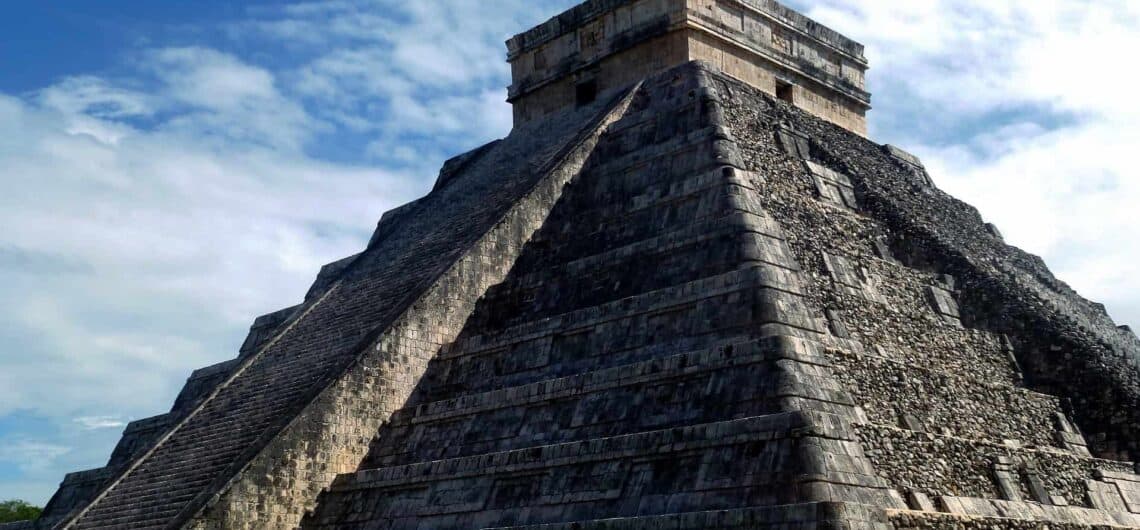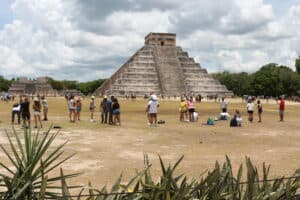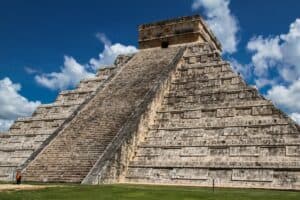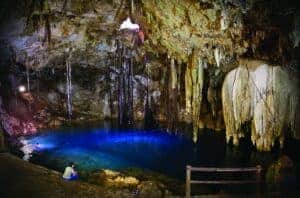

If you are about to visit the Yucatan peninsula, there is no doubt that you will stop a few hours at Chichen Itza, this splendid archeological site built by the Mayans and designated one of the Seven New Wonders of the World. Chichen Itza, with the pyramid of Kukulkan, is a place filled with history and traditions, with myths and culture representing the Maya civilization.
And if you have never heard about this place until now, this blogpost will certainly convince you to visit and discover this mysterious and must-see landmark of Yucatan !
________________________________________________________________________________________
History
Chichen Itza, meaning “at the mouth of the well of the Itza”, was founded by the Maya people around 550 AD after conquering the city and its surroundings, even though the debate is still active concerning the founding date of the site. It developed during the Classical Period (600-900 AD) by building its powerful, commercial and religious influence and became, by the tenth century, the capital of the northern coast of the Yucatan peninsula and the main religious center of the region, spreading its power to the western and eastern coasts of the peninsula.
The Mayans introduced the cult of Kukulkan, the Mayan representation of the Quetzalcoatl, one the main gods of the Toltec pantheon and built the main pyramid of the site to honor him. The city lost its influence and power by the middle of the thirteenth century, even though some pilgrimages were still done to the Sacred Cenote close to Chichen Itza. Finally, after the arrival of the Spaniards in Mexico during the sixteenth century, the site was officially abandoned until the nineteenth century when explorers rediscovered the sites and sacred artefacts in the cenote. The site then became a major place of archeological research and still nowadays discoveries are still made, revealing more and more secrets about Chichen Itza and its symbols.
Location
Chichen Itza is located in the eastern part of Yucatan state in Mexico, very close to the city of Valladolid. It was built at this strategic place for the proximity with underground rivers and four open sinkholes, or cenotes. This location close to diverse sources of water was very attractive and enabled the development of the settlement in the region as it provided water for domestic use, such as agriculture and rearing, but also for the religious dimension of the civilization.
Moreover, Chichen Itza was located at a strategic place on the main commercial routes, enabling the city to have easy access to the sea and obtain goods from distant lands, for example gold from the southern part of Central America, making the site a turning point of pre-Columbian trades.

The pyramid of Kukulkan
The most impressive monument of the city must certainly be the pyramid of Kukulkan. Measuring 98 feet with a large base of 181 feet, the pyramid was also nicknamed “El Castillo” by the Spaniards because of its resemblance with European architecture. Historical and archeological records estimate that El Castillo was built during the twelfth century by the Mayans.
The pyramid is a construction of nine square terraces and staircases of about ninety steps leading to the temple at the top and served as a temple to honor Kukulkan, known as the Feathered Serpent God, a Yucatec deity closely related to the Quetzalcoatl worshipped by the Aztecs. On the spring and autumn equinoxes, when the sun starts to go down on the northwest corner of the pyramid, it casts a shadow looking like a serpent making his way down the pyramid, reminding of the mythical Feathered Snake and therefore the god worshipped by the Mayans.

Archeological researches showed that El Castillo hides other smaller pyramids inside which might have been built before the main pyramid. Scholars and researchers estimate that this type of construction is pretty common on ancient Mesoamerican sites and speculate that this was a manner for the ruler to outdo their predecessors’ power by commanding the construction of a greater pyramid on top of the smaller one. Also, archeologists found a hidden cenote inside El Castillo and wonder whether this cenote was an alternative to the Cenote Sagrado and was the gate of entry to the Underworld.
El Cenote Sagrado
One of these cenotes, el Cenote Sagrado, close to the pyramid of Kukulkan, was one of the most important landmarks of the religious complex. Cenotes were considered as the gate to Xibalda, the Underworld, where the gods of rain lived. Therefore, the Cenote Sagrado was a place welcoming numerous pilgrims coming from the whole region to deposit valuable items and human bodies as offerings to the rain god Chaac. At the beginning of the twentieth century, the American archeologist Edward Herbert Thompson recovered gold, jade, human bodies and other artefacts, remains showing the importance of this cenote for the Mayan culture and religious beliefs.

________________________________________________________________________________________
Overall, the archeological complex of Chichen Itza is a must-see if you plan to visit the Yucatan peninsula. Filled with history and myths, this place is a wonder for the eyes and an incredible opportunity to learn a lot about the Mayan culture and history. You will be transported back to the past by discovering El Castillo, the main pyramid of Chichen Itza, as well as the Cenote Sagrado, believed to be the entrance to the Underworld.
So what are you waiting for ? With Best Maya Tours, you will be immerged for an entire day in the Mayan world, wandering around the site and discovering all its secrets thanks to our professional guide who will take you through your private journey to the Mayan world.
For more information, don’t hesitate to click on the following link or contact us through Whatsapp, Facebook, Instagram or by sending a mail at info@bestmayatours.com.
Hoping to see you there soon !
